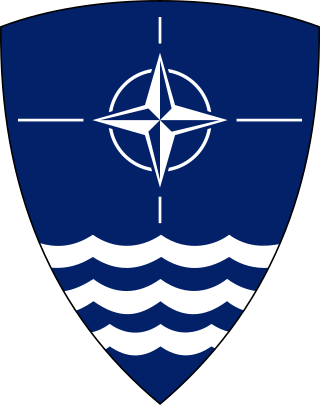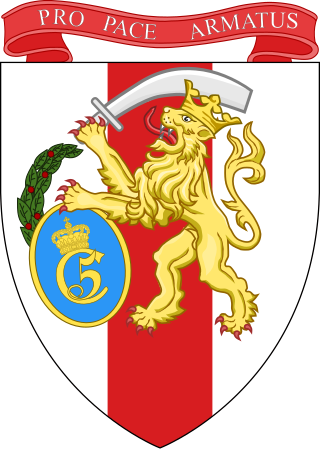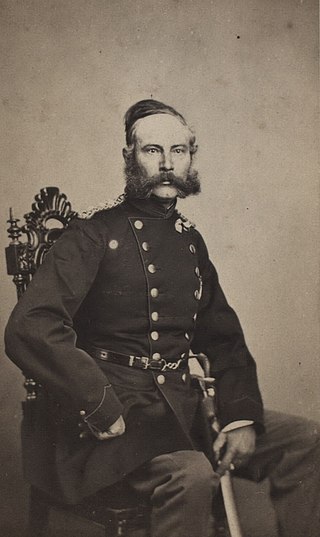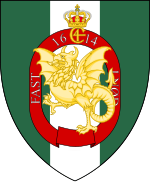A division is a large military unit or formation, usually consisting of between 10,000 to 25,000 soldiers. In most armies, a division is composed of several regiments or brigades; in turn, several divisions typically make up a corps.

The Royal Life Guards is a mechanized infantry regiment of the Danish Army, founded in 1658 by King Frederik III. The primary task is to provide a number of soldiers from the Guard Company to serve as a guard/ceremonial unit to the Danish monarchy, while training the Royal Guards for various functions in the mobilisation force. Until its disbandment, the Royal Horse Guards, served the role as the mounted guard/ceremonial unit, afterwards the role was taken over by Guard Hussar Regiment Mounted Squadron. During the time period 1684–1867, the Royal Life Guards were called The Royal Foot Guard, in order to distinguish between the regiment and the Royal Horse Guards.

The Prince's Life Regiment was a Royal Danish Army infantry regiment. The motto of the regiment was "Gloria Finis".

The Jutland Dragoon Regiment is the only regiment of the Royal Danish Army that has an armored (MBT) battalion, and is one of the Danish combat regiments in which soldiers are entitled to wear the black beret of the Armoured corps.

The Battle of Sehested was fought between Danish and Russian-Prussian-British troops at Sehested on 10 December 1813 during the War of the Sixth Coalition. The Danish Auxiliary Corps, which fought on the side of the French defeated the coalition forces commanded by Major General Ludwig von Wallmoden-Gimborn.

The Zealand Life Regiment was a Royal Danish Army infantry regiment. On 1 January 2001 it was disbanded and amalgamated into the Guard Hussar Regiment, which was moved from Næstved to Slagelse.

The Danish Life Regiment was an infantry regiment of the Royal Danish Army. On 1 January 2001 it was merged with the Zealand Life Regiment, into the Guard Hussar Regiment.

The Schleswig Regiment of Foot is a Royal Danish Army infantry regiment. On 1 January 2001, the regiment was merged with the Queen's Life Regiment to form the Prince's Life Regiment. In 2018, it was announced that the regiment would be reestablished on 1 January 2019 as a light infantry battalion.

The Falster Foot Regiment was a Royal Danish Army infantry regiment. On 1 August 1976 it was amalgamated into the Danish Life Regiment, where four out of five battalions continued to exist until 1981.

The 10th Regiment was a Danish Army infantry regiment. On 1 September 1961 it was merged with 8. Regiment and from 1 November 1961 the new regiment was known as Dronningens Livregiment. The name Feltherrens Fodregiment was never the official name, as the official name was 10. Regiment.

Allied Forces Baltic Approaches (BALTAP) was a Principal Subordinate Command (PSC) of the NATO Military Command Structure, with responsibility for the Baltic Sea area. It was in existence from 1962 to 2002 and consisted of the Danish Armed Forces, units of the West German Bundeswehr and allied wartime reinforcements.

The Jutland Division was a mechanized infantry formation of the Danish Army during the Cold War. It was formed during 1951-1952 as 3rd Division from assets of the III Military Region and the division headquarters was initially located in Aabenraa. As initially formed, the division had only one active brigade and two reserve brigades. The division changed its name to "Jutland Division" in 1961. In 1975, the division headquarters was moved to Fredericia and the 2nd and 3rd Brigades received full equipment sets. By 1979, each brigade was made up of two mechanized infantry battalion, a tank battalion, a self-propelled artillery battalion, and an armored reconnaissance squadron (company). In 1981 the three armored reconnaissance squadron was merged into V/JDR Reconnaissance Battalion.
The XIII Corps of the Grande Armée was a French military unit that existed during the Napoleonic Wars. The corps was formed in the spring of 1813 and Marshal Louis-Nicolas Davout was appointed as its commander. The corps included three French infantry divisions and attached cavalry. During the German campaign, the XIII Corps was assigned to defend northern Germany. Accordingly, Davout seized Hamburg and prepared to defend it against the Allies. In September 1813, one brigade was defeated at the Battle of the Göhrde. After Emperor Napoleon I's decisive defeat at the Battle of Leipzig in October, the XIII Corps became isolated in Hamburg. An Allied army under Russian General Count von Bennigsen initiated the Siege of Hamburg in December.

The Jutlandic Regiment of Foot was a Royal Danish Army infantry regiment. On 1 November 1961, it was amalgamated with the King's Regiment of Foot, to create the King's Jutlandic Regiment of Foot.

The King's Regiment of Foot was a Royal Danish Army infantry regiment. On 1 November 1961, it was amalgamated with the Jutlandic Regiment of Foot, to create the King's Jutlandic Regiment of Foot.

The Queen's Life Regiment was a Royal Danish Army infantry regiment. On 1 January 2001, it was amalgamated with the Prince's Life Regiment.

The King's Jutlandic Regiment of Foot was a Royal Danish Army infantry regiment. On 1 November 1991, it was merged with the Funen Life Regiment, into Schleswig Regiment of Foot.
This article lists the structure of the Royal Danish Army in 1989 and in May 2020:

The Western Regional Command was the overall command of all Royal Danish Army units in Jutland and on Funen. It was split into four military regions, and was responsible for the regional defence. In 1990, the Regional Commands were disbanded and control was collected at the newly created Army Operational Command.

Carl Philip Friedemann Maximilian Müller, more commonly known as Max Müller was a Danish officer who served in the First and Second Schleswig Wars.



















